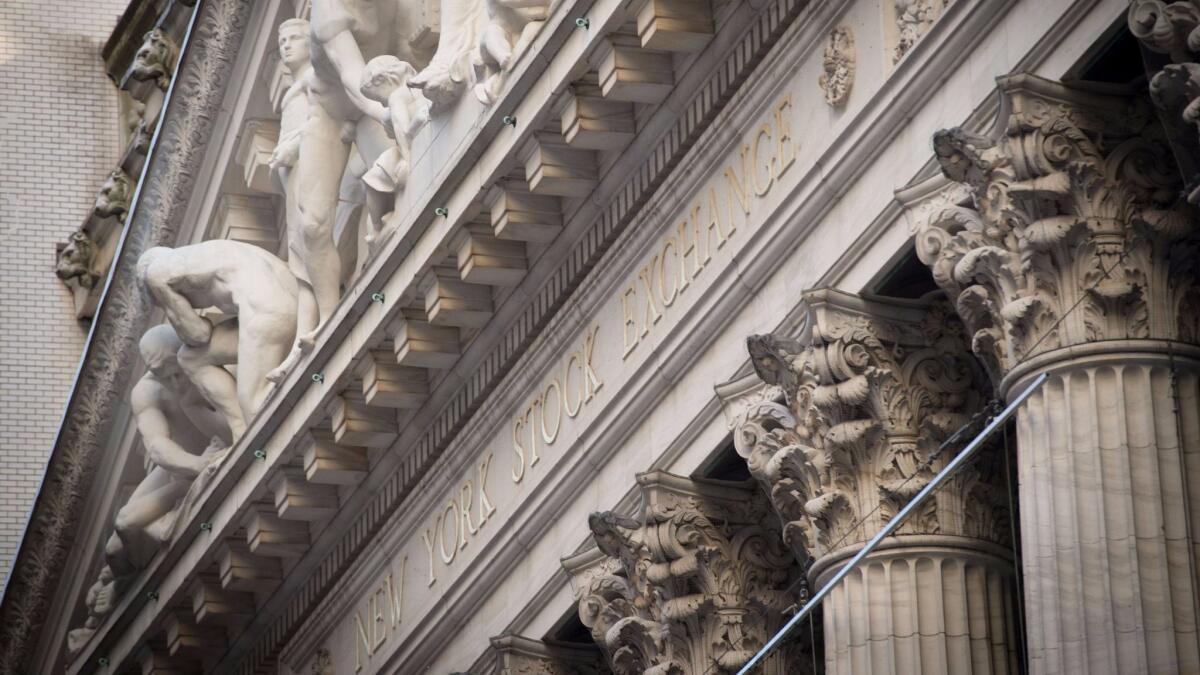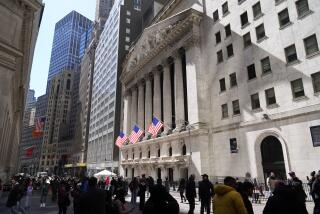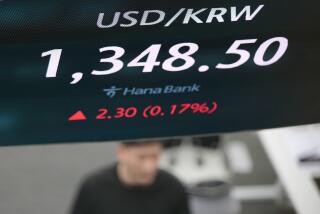Stock indexes hit new record highs, lifted by job growth

A broad-based push higher for stocks sent indexes to new highs Thursday after yet more signs that the job market continues to improve.
The Standard & Poor’s 500 index pierced the 2,420-point level for the first time during the morning and kept going. It ended at 2,430.06, up 18.26 points, or 0.8%. The Dow Jones industrial average climbed 135.53, or 0.6%, to 21,144.18, and the Nasdaq composite jumped 48.31, or 0.8%, to 6,246.83. All three indexes set record highs.
Smaller stocks had even bigger gains, and the small-cap Russell 200 index leaped 25.85, or 1.9%, to 1,396.06, though it remains shy of its record.
Driving stocks higher was a report indicating that employers picked up their hiring last month. Payroll processor ADP said private businesses added 253,000 jobs in May, more than economists expected. It’s a reassurance, particularly when growth of the overall economy has remained frustratingly tepid.
Read more: ‘Job growth is rip-roaring’: Companies accelerated hiring in May »
The U.S. government’s more comprehensive report on jobs will arrive Friday. It will include hiring by all non-farm employers, and economists expect it to show growth of 176,000 jobs in May.
The payroll report gave more encouragement to investors, many of whom were already looking to buy.
“The market’s ahead of itself, but I’m not surprised that the market is ahead of itself,” said Linda Duessel, senior equity strategist at Federated Investors.
Duessel talks often around the country with financial advisors managing money for clients, and many tell her they see any pullback in stock prices as a quick opportunity to buy rather than as a source of concern. That hunger to buy means the S&P 500 has gained within just months what Duessel thought may take a year or so to achieve, given continued economic growth and few signs of a looming recession.
“What you have, it would appear, is an acceleration in earnings with a low inflationary environment, which is Goldilocks,” Duessel said.
President Trump’s announcement late in the trading day that the U.S. would withdraw from the worldwide agreement on climate change had little effect on markets.
Other reports on the U.S. economy were mixed Thursday. Manufacturing growth picked up last month and was stronger than economists were expecting, but construction spending unexpectedly weakened in April. A separate report showed that the number of workers filing for unemployment claims rose last week, which could be an indication that layoffs are on the rise. The number remains low by historical standards.
The stock market’s gains were widespread, and all 11 sectors that make up the S&P 500 rose. Healthcare and financial stocks led the way. Producers of raw materials and companies that sell non-essentials to consumers were also particularly strong.
Discount retailer Dollar General jumped 6.5% to $78.19, one of the biggest gains in the S&P 500, after it reported stronger earnings for the latest quarter than analysts expected.
Deere rose 1.8% to $124.70 after it agreed to buy Wirtgen Group, a German maker of road-construction equipment, for about $5.2 billion, including debt.
Box climbed 9.5% to after the online storage provider posted quarterly results that impressed investors.
Palo Alto Networks jumped 17.2% to $138.99 after the security software company posted quarterly results that beat expectations.
PPG Industries rose 2.6% to $109.16 after the chemicals company abandoned efforts to buy Dutch rival AkzoNobel, which has rejected its takeover approaches three times.
On the other end was Hewlett Packard Enterprise, which slid 6.9%, to $17.52, the largest loss in the S&P 500, after it reported disappointing quarterly results.
Express dived 19.2% to $6.27 after the clothing retailer said discounts cut into its first-quarter profit margins and it lowered its annual outlook.
The yield on the 10-year Treasury note held steady at 2.21%. A stronger job market gives the Federal Reserve more leeway to raise interest rates, and its next meeting on rate policy is in two weeks. The central bank has been gradually pulling rates off their record low following the Great Recession, and it has raised them twice since December.
The dollar rose to 111.33 yen from 110.57 yen. The euro fell to $1.1214 from $1.1246, and the British pound slipped to $1.2876 from $1.2892.
Benchmark U.S. crude oil rose 4 cents to $48.36 a barrel. Brent crude, used to price international oils, fell 13 cents to $50.63 a barrel. Natural gas fell 6 cents to $3.01 per 1,000 cubic feet, heating oil fell 2 cents to $1.50 a gallon, and wholesale gasoline stayed at $1.60 a gallon.
Gold fell $5.30 to $1,270.10 an ounce, silver fell 13 cents to $17.28 an ounce, and copper rose a penny to $2.59 a pound.
In overseas markets, France’s CAC-40 gained 0.7%, Germany’s DAX advanced 0.4% and London’s FTSE 100 added 0.3%. Tokyo’s Nikkei 225 jumped 1.1%, Hong Kong’s Hang Seng rose 0.6%, and South Korea’s Kospi shed 0.1%.
UPDATES:
3:20 p.m.: This article was updated with closing prices, context and analyst comment.
9:50 a.m.: This article was updated with market prices and context.
This article was originally published at 7 a.m.






